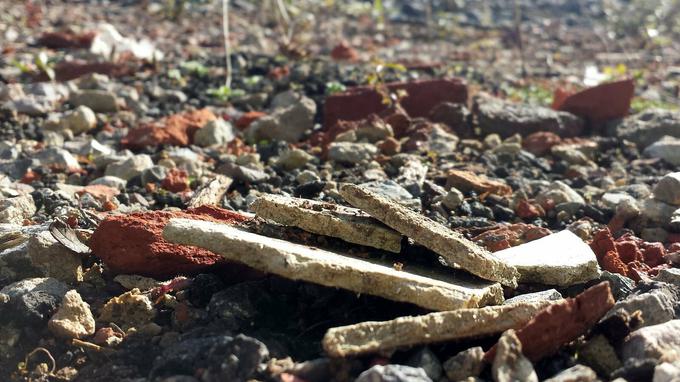
James Macfarlane, Hydrock’s specialist lead on managing the risks associated with asbestos in soils, recently gave a Q&A interview to Brownfield Briefing ahead of his session at the Brownfield Land Wales 2018 conference. With kind permission of Brownfield Briefing, we have reproduced James’s insights below.
Q. What are the longer-term risks of re-using asbestos-affected soils and how it should be monitored over time?
When assessing the long-term risk of re-using asbestos contaminated materials, the assessment should not be limited to the potential health and environmental effects. Whilst the health and wellbeing of the end-users must always be of paramount importance, the re-use of contaminated soils should always be accompanied by an assessment of the long-term socio-economic and political effects. Long-term risks such as property blight, asset value, asset management, developer liability, community concern and potential changes in legislative, industry and regulatory guidance should also be considered. Assessing these variables (among others) will allow a more robust and forward-thinking risk register to be compiled, which, in turn, may future-proof the development whilst protecting the interests of both the landowner/developer and end-users.
Currently, the reuse of asbestos in soils focuses on the pollutant-linkage between contaminant, receptor and pathway. Asbestos is an unusual contaminant in that the dose-response relationship, health effects and transmission method to the receptor are all understood. However, in order to fully assess the pathway to the receptor there is a need for reliable field data on the ease of transportation, potential soil-to-air release, cumulative activity-based exposure, respirable fibre index, rates of degradation and background level within the UK, each of which is characterised by a lack of reliable field data and are not all that well understood. This uncertainty makes the use of this model difficult as a standalone-tool for predicting cumulative exposure, such that a multiple ‘lines of evidence’ approach should be used when undertaking the risk assessment for the re-use of any asbestos contaminated soils, even at low-levels.
That said, there are attributes which can be reliably used to make long-term management decisions:
- Asbestos is (in general) immobile in soil when retained at depth
- Asbestos exposure can only occur when fibres of respirable size are disturbed and become airborne
- Risk to the receptor increases with increased extent and frequency of cumulative exposures
- The age of the receptor (i.e. people) matters, with younger people being at greatest risk
- The potential for soil-to-air fibre release increases as the proportion of loose fibre within the soil increases
- Moisture content will have a significant impact on reducing the potential for soil-to-air fibre release
- Soil type will have an impact on potential soil-to-air fibre release, with more cohesive soils providing the greatest inhibition to release
- Bound/bonded asbestos fragments will degrade over time leading to a greater proportion of loose fibres than may have been anticipated.
Consultants normally advocate the re-use of low risk material at depth, in a less sensitive area of the site, to ensure the pathway link to the receptor is broken. The advice will often include a requirement for hand picking of visible fragments to limit the potential for degradation, thereby reducing the propensity for future release of loose fibres, all followed by the installation of a clean cap or hardstanding. Such proposals are an acceptable course of action assuming that the material complies with the ‘Definition of Waste’ CL:AIRE Code of Practice and is suitable for re-use. The long-term risk assessment must show that there is no unacceptable human health risk to future users and without an exposure pathway there is no such risk.
It is therefore prudent to ensure that a long-term management strategy is implemented on any site where asbestos-contaminated soils are re-used. Of course, for that strategy to be of value, it is essential that during the construction phase the location of the material is properly surveyed, recorded and that there are adequate provisions to ensure that such information is carried forward either within deeds, via an asbestos management plan/register, or included as part of the development’s health and safety file.
It should be emphasised that the risk to future users is mainly derived from contaminated material brought to the surface where there is a potential for fibres to become airborne and inhaled. In the long term, this process could occur as a result of the degradation of capping layers over time, burrowing animals, excavation by construction and maintenance staff or gardening activities in a residential setting. Ensuring that encapsulation/capping layers are regularly inspected and maintained in a good condition ensures that the contaminated soils remain at depth without the opportunity to create exposure.
Ideally, asbestos-contaminated materials should be placed in locations where it is unlikely that they will ever need to be disturbed during the lifespan of a development (e.g. below POS or the building footprint). However, where this option is not possible, the location of placed material should be recorded in such manner that future maintenance staff are aware of the risk so that appropriate control measures and material handling can be implemented. This recommendation not only ensures that the construction workers are protected, it also ensures that the arisings are appropriately managed and that the clean cap is properly reinstated upon completion.
Q. How do regulator’s views on re-use vary?
The regulators’ attitudes to ‘how’ work should be undertaken has largely been defined with the release of CL:AIRE’s excellent guidance titled ‘Interpretation for Managing and working with Asbestos in Soil and Construction and Demolition Materials’ (CARSOIL). The guidance has effectively identified the difficulties and discrepancies of integrating the Control of Asbestos Regulations 2012 with other requirements of the contaminated land industry. There is now definitive guidance on how material should be processed, handled and placed, together with the necessary Health and Safety precautions. Any work conducted on asbestos contaminated land should comply with CARSOIL if it is to withstand the scrutiny of the Health and Safety Executive.
However, there remains a high variability in attitudes towards the ‘where’ and ‘when’ of on-site re-use. This process is largely controlled by the approval system within each Local Authority, which is variable due to lack of a clear, industry-wide reuse criteria; approval is very much based on each local authority’s environmental teams’ interpretation of risk. Where there is ambiguity, the response will be reliant on personal preference, so the regulatory position tends to differ between offices and individuals.
That said, by providing Environmental Health Officers (EHO’s) with good quality data, reasoned justification, and a long-term management plan, greater consistency in decision-making can be achieved.
EHO’s are looking for re-use criteria that limit the impact on the end user (to no unacceptable risk), comply with the CL:AIRE ‘Definition of Waste’ Code of Practice, increase the sustainability of a project and clearly show that re-use is not being undertaken solely for commercial reasons. EHO’s are often open to dialogue, and provided that there is a clear reasoning, are also open to re-evaluating their position.
Q. How common is cross-contamination with asbestos?
Cross-contamination with asbestos is frequent within the UK because there are so many sources. This conclusion is particularly evident when looking at ‘low level’ and ‘trace’ contamination. Low-level quantification testing is extremely sensitive, in that a single fibre within a sample will render the source material to be classified as containing <0.001% or <0.0001% (dependant on method). Given that some re-use criteria require material to be ‘non-detect’, this target becomes difficult to achieve. The issue is particularly prevalent in residential developments where material is destined for placement as topsoil within a residential garden.
Cross-contamination may occur from ineffective material management/tracking, environmental contamination, contaminated materials being processed elsewhere on-site or any other site process where dust control measures are ineffective.
The following are some key points to consider to minimise cross-contamination:
- Ensure a comprehensive ground investigation has been undertaken prior to any excavation; know where the high-risk areas are, then segregate, stockpile and quarantine the material appropriately from other ‘cleaner’ materials
- Maintain a comprehensive and well documented ‘Materials Management/Tracking’ system
- Ensure competent and asbestos-trained contractors are deployed with a clear procedure with defined steps to be taken if visible contamination is identified
- Programme excavation works to deal with potential sources first; for example, leave natural material in situ until all demolition and Made Ground has been dealt with appropriately
- Employ sound, site-based, material management and effective control measures (particularly nuisance dust mitigation)
- Take account of potential sources of fibre in the local environment. For example, a 10,000m² asbestos cement clad warehouse on the neighbouring site could cause you issues!
- Sample any imported material at source or as soon as it arrives onsite. Delivery of ‘clean’ import material to site can quickly become contaminated once it arrives on a development site with poor controls.
Another source of cross-contamination that should be considered is during demolition, where incomplete or substandard removal of asbestos has been conducted prior to demolition taking place. It should be noted that even the most comprehensive asbestos removal operation cannot remove all asbestos fibres from a building. However, a considered demolition specification can assist in segregating demolition arisings to ensure as much of the materials are free of contamination as reasonably practicable. Additionally, dust mitigation is essential during demolition, as it will help to prevent fibres being spread across an otherwise ‘clean’ site.
Q. How many different remediation and re-use techniques are being used?
Onsite remediation techniques have changed very little in the past 5 years, with the majority of methods relying on mechanical segregation, handpicking, and screening, followed by the ever-expensive off-site disposal options.
More recently, options have become available at off-site treatment centres with permits granted by the Environment Agency, which offer specialist asbestos treatment facilities. The number of sites offering this service is small, so cost effectiveness relies either on haulage routes or opportunistic site location. Also, such sites are generally only able to accept bonded asbestos and the constraint of residual fibres post treatment has not been resolved.
With regards to re-use, again, there has not been much recent technical development, and the focus continues to be on burial at depth with suitable capping, marker and break layers. However, some older technologies are now starting to be used for asbestos in soils. Methods such as solidification and stabilisation are becoming more common, but they are usually accompanied with burial at depth.









































































